I’ve been home for a week with my second bout of COVID. This one came creeping in with Adriana after she returned from a bonspiel (a weekend curling competition/party in Roseville) and after a few days we were both down for the count. Should be ok in another 2-3 days max. I haven’t been blogging for a long time again. When I tried to focus on it, other things kept distracting me. At least my novel is done (for now). I have it at a 2nd publisher after it was rejected by the first, and a friend is working on a TV-series treatment, so we’ll see where we are in a month or two. One of my major goals with the novel was to make nature itself a character. I did this by way of a bioengineered fungus and the unexpected relationships developed in and around it as it proliferates in the San Francisco of the near future. I’m not sure if I pulled it off, but eventually we will see.
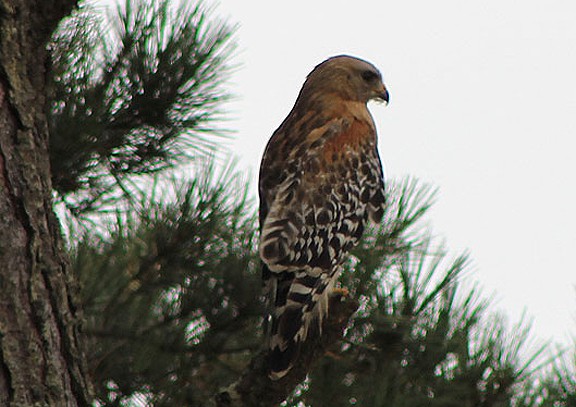
Red-Shouldered Hawk near Lake Merced in 2014.
Anyone who knows me knows that I am not a pet person (and definitely NOT a dog person!). I don’t have any animals in my life that I have a direct relationship with that way (though I grew up with cats when I was a child, so I usually have an easy rapport with any cat I come close to even if I’m allergic to them now). On the other hand, I’ve become quite a big “fan” of bird watching and after the most recent rainy trek through Golden Gate Park (on my March 11 birthday) with Josiah Clark, I’ve enjoyed at least four straight years of getting to know the abundant springtime bird life that graces that part of town (around 80+ distinct species!). I’m also an enthusiast for the regular presence of wild coyotes in our local open spaces, the midnight visits from giant raccoons that patrol our backyard, the seals and sea lions that duck under the water as our boat nears them in the bay, and the many charismatic large birds that I encounter whenever I approach the bayshore.
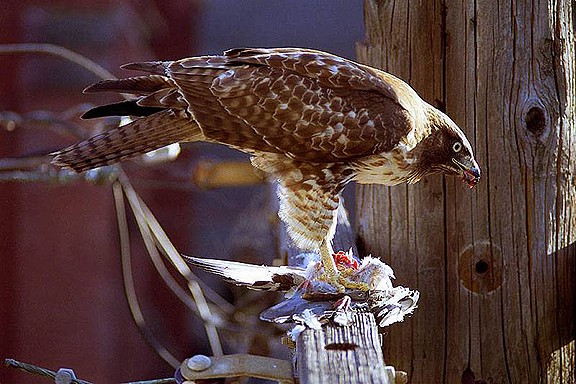
Redtailed hawk munching a pigeon on Thanksgiving Day 2002 at 19th and Dolores.
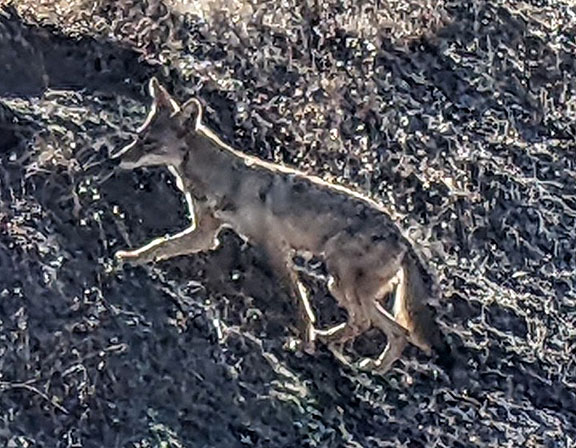
Coyote skirting slopes of Bernal Heights in 2022.
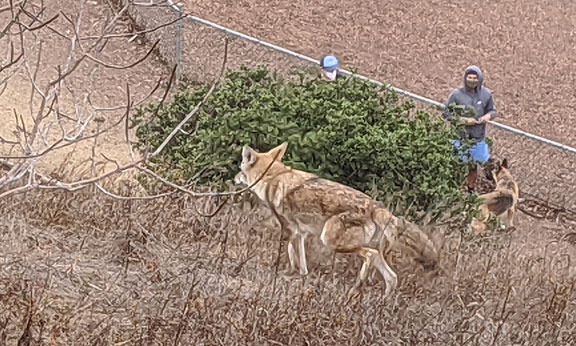
Here’s a coyote on Corona Heights in 2020 with a woman walking her dog just beneath at the right.
…the necessity of communicating impressions, of playing, of chattering, or of simply feeling the proximity of other kindred living beings pervades Nature, and is, as much as any other physiological function, a distinctive feature of life and impressionability.
—Peter Kropotkin, Mutual Aid, 1902 (PM Press: 2021)
The shifting baseline of our expectations is inseparable from the crisis of biodiversity. We grasp for the butterflies, bees, and native plants that were once the dense fabric of local ecology and are now the remaining loose threads. Local efforts to repair “natural areas” have had some success (we’ll be touring some of them by bike on April 23), but we don’t know what it’s like to have the sun disappear behind billions of birds flying overhead for days on end, as the early European visitors did. The radical abundance of elk, bear, salmon, ducks, and so many other species that the first visitors described are now recognized to be an anomalous outcome of the microbial invasion that predated the actual arrival of European colonists.
California was the densest populated area of North America and it was largely without sedentary agriculture. Nevertheless, the landscape was cultivated and managed. The close proximity to dozens of other groups, many speaking radically different languages, led to a California full of mutual tolerance and relatively clear boundaries for gathering acorns, berries, greens, roots, and game. And the dense human population kept the numbers in check for large predators as well as herds of ruminants. When the California Indian population began to succumb to new diseases in the late 1600s and early 1700s, the animal populations began to explode, so that when European colonists arrived the land seemed full of wild life in a way that had probably seldom been the case for centuries.
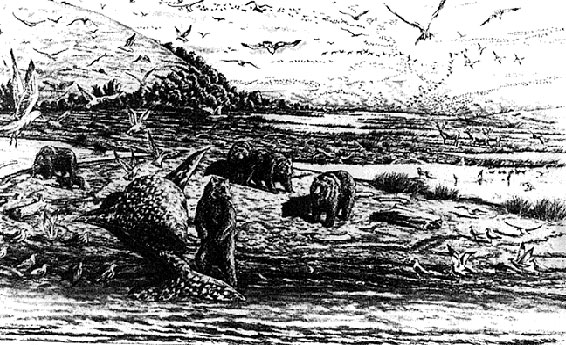
A depiction of what it might have been like at Candlestick Point in pre-colonization times. (image courtesy The Ohlone Way)
…the road to [nearby Mission Dolores] was easily recognizable from the heads of bulls and the bones and carcasses of dead horses scattered everywhere; the foul smell from them and the flocks of crows, seagulls, and various hawks devouring all of this carrion usually means the proximity of habitations. I think that this province is indebted solely to the feathered kingdom for protection against infections and epidemic disease.
—Excerpt from Andrey Lazarev’s Journal of a Visit to Alta California 1823-1824 (in California Through Russian Eyes, 1806-1848, Volume 2, compiled, translated, and edited by Janes R. Gibson, The Arthur C. Clark Company, University of Oklahoma Press, Norman OK: 2013)
The cow was the ecological time bomb par excellence. Nothing changed California as much as the arrival of cattle and all the species it brought along with it. By the end of the 1700s, just a generation after coming to settle in California, wild herds of cattle and horses were expanding rapidly in the wetlands of the Central Valley, displacing the elk herds that depended on similar terrain. In the 1820s, as cited in the quote above, cows and horses were so hyper-abundant that they were slaughtered and left to rot seemingly everywhere.
I’ve been reading and (occasionally) writing about food for a while now. A big part of my interest is fueled by San Francisco’s long history in industrial food production and distribution (with major brands like Del Monte, Hills Brothers, MJB, and others once located here), which made up a major part of the local economy throughout the United States history of this place. A key company that gained control over meat production in northern California in the 19th century was Miller & Lux. Mostly I’d heard about them in the context of the famous lawsuits over water rights that set in place precedents that still dominate California water law to this day (Lux v. Haggin). But I recently read a lively history called Industrial Cowboys: Miller & Lux and the Transformation of the Far West, 1850-1920 (David Igler, University of California Press: 2001) where I got a better sense of how much the early consolidation of the cattle industry shaped the San Joaquin Valley but also San Francisco itself. The creation of what was then called the “Butchers’ Reservation” off Third Street along Islais Creek set in motion a chain of events which led directly to the 20th century placing of the city’s largest sewage treatment plant where tanneries used to be, and the location of a large fossil fuel plant not far from the edge of the meatpacking district, as well as building the Navy’s radiological lab at nearby Hunters’ Point, which received all the debris from H-bomb testing in the South Pacific.
Another layered industrial trajectory can be traced on the land south of San Bruno Mountain, where today the towns of South San Francisco and San Bruno stand, and just beyond them, the San Francisco International Airport. Originally this was all part of the Buri Buri rancho, a land grant that pertained to Mission Dolores until secularization in the 1830s led to its allocation to the Sanchez family.
The Buri Buri contained easily irrigated land with rich soils located less than five miles from San Francisco. An 1858 boundary survey noted the land’s many natural resources and improvements: “Laguna de San Bruno,” “Laguna Alta,” and the “Sanchez Ditch,” as well as natural streams, “oak grove[s],” and the “San Jose Stage Road,” which crossed thousands of acres of prime grazing land. More desirable land could hardly be found in California, and San Francisco’s proximity only increased Buri Buri’s value and appeal.
—Igler, Industrial Cowboys, p. 47
Following the pattern of land grabs and fraudulent land schemes that befell Mexican land holders this rancho was sold to butcher Charles Lux in 1853, where with Henry Miller, he processed a herd of 1600 cattle in 1856, pocketed the profits, and then rejoined Miller in a permanent partnership in 1858. This was the beginning of what became the West’s largest landholder, largest water rights holder, and biggest meat processor into the early 20th century.
In Animal City: The Domestication of America, Andrew Robichaud tells a detailed history of San Francisco’s slaughterhouses, which began near “Cow Hollow” along Larkin on the western slopes of Nob Hill in the early 1850s. Then after vociferous complaints from neighbors slowly spreading over the hill from the city to the east, by the Civil War period several dozen slaughterhouse operations had set up shop along Mission Creek near the Brannan Street bridge (at 9th). As the city’s urban neighborhoods spread inexorably towards that area, pressure built and the city’s first-ever Board of Health director began a “war on the butchers.” By 1871 everyone had been coerced or cajoled into moving further south, to what became Butchertown near today’s 3rd and Evans. At the time it was on the muddy banks of the tidal wetlands of Islais Creek, and the assumption was that the buildings built over the mudflats could dump the offal and blood and other waste directly into the ground and it would be flushed away by tidal action. Robichaud says there’s no documentary evidence, but the new Butchertown helped the biggest butchers to consolidate their control over local markets. Butchertown’s new facilities were too expensive for many of the previous small scale butchers to use; on the other hand, it was perfect for the well-capitalized Miller & Lux, and it was located precisely between their large holding ranch in South San Francisco and the market in downtown.
Competing meatpackers still landed their herds at the foot of Second Street, close to today’s Giants’ stadium. An 1880 ordinance prescribed the exact route for livestock to take from the Second Street wharf to Butchertown, where in one month in 1878 some 30,000 cattle, sheep and hogs were unloaded:
San Francisco ordinance 1587, passed in 1880… carved a single path for driving cattle from the Second Street Wharf to Butchertown: “But is is lawful to drive cattle from the landing at the foot of Second Street along King Street to Third Street, then to Berry, then to 6th Street, then along Sixth to Townsend, along Townsend to Seventh Street, then to Brannan, then to Ninth Street.” The path led out to parts of town where keeping cattle was legal, and specifically to Butchertown. General Orders of the Board of Supervisors Providing Regulations for the Government of the City and County of San Francisco. (footnote 43 in Chapter 4 of Animal City)
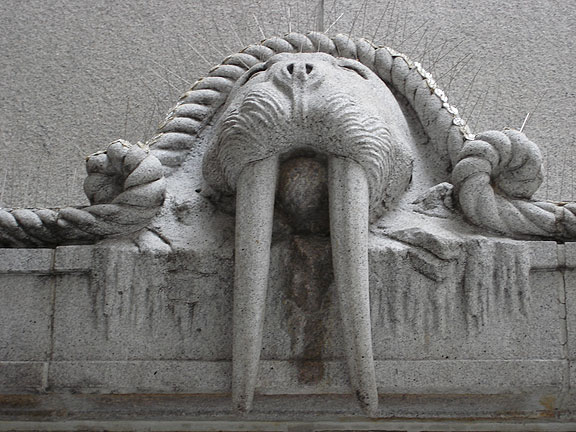
The old granite walrus head that used to grace the exterior of the Alaska Commercial Corporation building and is now on the US Bank building in 200 block of California. No clearer example of capital: reducing the pulsing life of the Pacific rim to the dead capital of real estate in San Francisco’s downtown. (h/t Gray Brechin)
When Charles Lux dies in 1888, his Buri Buri ranch is purchased not by Henry Miller, but by Gustavus Swift of Chicago’s American Cattle Trust, who uses the land to launch a systematic assault on the San Francisco market. Using their newly built state-of-the-art facilities in Baden (later renamed South San Francisco), Swift’s Western Meat Company survives the 1906 earthquake and fire and by the end of the 1910s has driven Miller & Lux out of business.
With the industrial slaughterhouses moved outside city boundaries altogether, a long process of separating humans from daily interaction with the animals on which they depended was consolidated. Robichaud does a great job of showing how changing mores regarding animal welfare accompanied this political economic transformation. The founding of the Society for the Prevention of Cruelty to Animals (SPCA) during the late 19th century was crucial. The private organization was granted independent police and fining authority to levy and collect the money it needed to carry out its duties, and for most part it carried out a class-biased agenda of persecuting, e.g., the poor “bone and rag man” who had an old nag to pull his cart through the streets as he gathered trash. It was precisely the poorest San Franciscans who depended on animal labor provided by the least healthy animals who were most closely policed by the new SPCA.
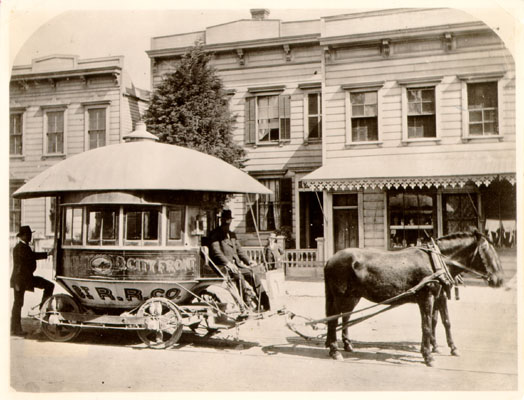
The balloon car, one of many horse-drawn vehicles in the 19th century.
In the thousands of cases prosecuted from 1878 to 1919, none—or an elusive few—were cases brought against corporations…. “Junk wagons,” “vegetable peddlers,” “milk wagons,” and “butcher wagons,” were overrepresented in SFSPCA prosecutions. These wagons and carts were pulled by horses of workers who not only stood out as needing reform, but whose relationships to and accountability for their workhorses was unmediated by corporate structures. Many probably only owned one horse and did not have the means to rest or replace old or lame animals. The enforcement of animal welfare laws fell disproportionately on them. (Robichaud, p. 145)
The bulk of animals in modern life are those that are either ready, or getting ready, to be eaten. I am no vegetarian, though I do understand the logic asserted by vegans and others who want us to shift our personal behavior to lessen the load on the planet by reducing our dependence on the carbon-intensive livestock industries. While I’d be willing to participate in a broad social conversation and movement to transform how we relate to meat, to animals, and to factory farming (it’s an urgent necessity actually), I’m not willing to engage in the moralizing individualism that emerges from those seeking to purify their personal consumer choices. As individuals we have little impact but if we could find a way to gather our forces to transform how we produce food (and transport, communications, housing, et al), to reorganize ourselves on a solid foundation of our shared commons, I’m all in.
It’s incredibly easy to invoke the ongoing ‘Organ Recital’ of the collapsing planet. Extinctions are accelerating and with the planned expansion of oil and gas production as recently reaffirmed by Biden and his crackpot pragmatism, combined with the new Law of the Sea treaty which I’m sure will soon reveal that it has authorized the strip-mining of ocean seabeds near and far, everything is sure to worsen rapidly. Glacial melt, ocean current alterations, the whipsawing between drought and flood… hey it’s a wild ride and it’s only going to get wilder.
Peter Alagoa cites Ray Dasmann, a California ecologist (author of the 1965 classic The Destruction of California) who had a huge influence on Peter Berg and Judy Goldhaft and the whole Planet Drum focus on Green City as a paradigm of activism. And they, in turn, had a big influence on me and the foundation of Shaping San Francisco and its ongoing emphasis on urban ecological history.
In the 1960s, pleas for scientists to study urban environments grew more urgent. Raymond Dasmann, a critic of growth in his home state of California, advised his colleagues to “get out of the woods and into the cities.” He believed that ecologists could help reshape urban areas into places “where each person’s everyday life will be enriched to the maximum extent possible by contact with living things and natural beauty.” For Dasmann, this was a key element of the “new conservation,” which focused not only on the sustainable use of natural resources in rural areas but also on the overall quality of the environment. (The Accidental Ecosystem, p. 110-111)
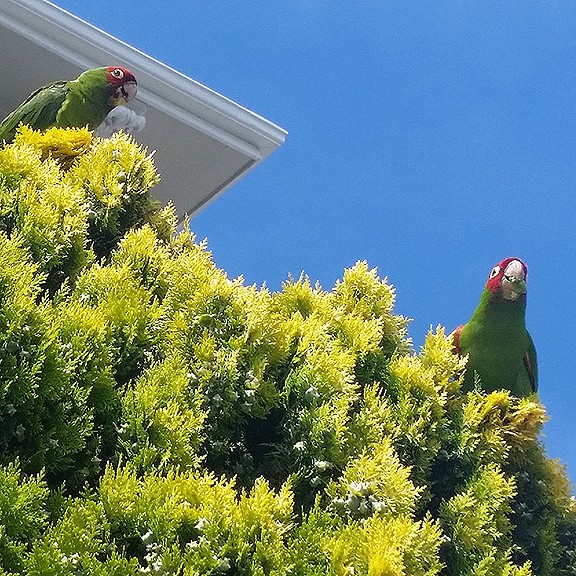
Wild parrots in Noe Valley in 2017.
I’m just reading Tom Philpott’s recent book <em>Perilous Bounty: The Looming Collapse of American Farming and How We Can Prevent It, and as the title indicates its another piece of our unravelling world. It confirms things I’ve already learned elsewhere during the past few years, but it’s a fine summary of the (horrifying) science—California’s San Joaquin Valley, unsustainably farmed for a century (and suddenly being inundated by the long-dry Tulare Lake which is roaring back to life under the deluge of this winter’s storms), cannot sustain its yields much longer, between depleted aquifers, chemical saturation of the landscape, and a dire combo of subsidence and erosion. Even worse is the insane concentration of corn and soy grown in the midwest, where soil loss carries a hyper-saturated brew of pesticides and fertilizers into the rivers and eventually the Gulf of Mexico and Lake Erie. The extreme concentration of industrial pig production near the corn and soy surpluses leads to a ridiculously high concentration of fecal waste in Iowa, where the pigs generate the equivalent of almost 3000 people per square mile worth of shit. The craziest part is how unprofitable corn and soy production are for the actual farmers.

Wild bee on the plum blossom tree outside my window in the Mission in 2014. Local bees and honey are still thriving.
This seemingly inevitable descent into collapse is rooted in the Cartesian myth that humans are the only intelligent beings and other life forms are basically running on some kind of mechanical autopilot in response to external stimulations and instinctual programming. In contrast to this, there are many writers dedicated to shifting our perceptions and relationships in such profound ways that it may open doorways out of this mess we hadn’t even noticed. I blogged about David Abram’s fine work previously but I do want to remind readers of how spot-on his musings are. Ed Yong has written two best-sellers that radically challenge what we know about life. In I Contain Multitudes: The Microbes Within Us and a Grander View of Life he explores the relatively understudied world of the microbiome—the teeming population of microbes that coexist in our bodies and might shape our personalities, desires, appetites, and more.
To peer into this world is to peer into William Blake’s grain of sand. When we begin to understand our microbiomes, our symbionts, our inner ecosystems, our staggering multitudes, every walk bristles with opportunity for discovery. Every innocuous bush sings with incredible stories. Every part of the world is full of partnerships that have been playing themselves out for hundreds of millions of years, and that have affected all the flora and fauna we know.(p. 264)
He cites some recent science that finds a much higher diversity of bacteria in the guts of herbivores compared to carnivores, and, giving additional ammo to vegans, draws the interesting conclusion that
“mammalian success was founded on vegetarianism, and that vegetarianism was founded on microbes. Time and again, different groups of mammals swallowed plant-breaking microbes from their environments, and used their enzymes to mount assaults on leaves, shoots, stems, and twigs… The team showed that the gut microbiomes of plant-eating vertebrates were particularly distinct from anything else—from environmental communities, from carnivores, from other body parts, or from invertebrates. Guts may be special, but a vertebrate gut is especially special, and a vertebrate gut that’s full of plants is special squared. (p. 177 and 179)
Yong’s work dovetails nicely with another recent book Entangled Life by Merlin Sheldrake in which the author takes us on an excursion through the world of fungi. This book finds fungi being developed for manufacturing as a possible replacement for wallboard, wood, plastics, and more. Sheldrake advances the paradigm rooted in biological sciences that is steadily eroding the reductionist science at the heart of industrial society.
To talk about individuals made no sense anymore. Biology—the study of living organisms—had transformed into ecology—the study of the relationship between living organisms. To compound matters, we understood very little. Graphics of microbial populations projected on a screen had large sections labeled “unknown.” I was reminded of the way that modern physicists portray the universe, more than ninety-five percent of which is described as “dark matter” and “dark energy.” (p. 17)
Another excellent book on the burgeoning field of mycology, made famous decades ago by Paul Stamets but now having a real renaissance, is In Search of Mycotopia: Citizen Science, Fungi Fanatics, and the Untapped Potential of Mushrooms by Doug Bierend (Chelsea Green: 2001). I learned about this book from an excerpt in the Earth Island Journal, which I’ve kept up a subscription to for years now. Glad I do! The book starts with a bunch of old mushroom hunters in typical clubs but quickly supercedes that old-school approach to mycology to delve into the DIY mycology movement, where entities have names like Smugtown and the Spore Liberation Front. Self-taught cultivators are spreading knowledge and resources through a well-developed underground network, mimicking the mycorrhizal networks they and others have been inspired by:
… we don’t “use” fungi, but rather “partner with” them; we meet mushrooms in the woods; people had come to the convergence to “expand the mycelial network,” and to “spread spores.” Underlying all this, principles of emergence and systems thinking emphasized decentralized, nonhierarchical communities, kind of like mycelium itself, a comparison that didn’t go unnoticed. (p. 141)
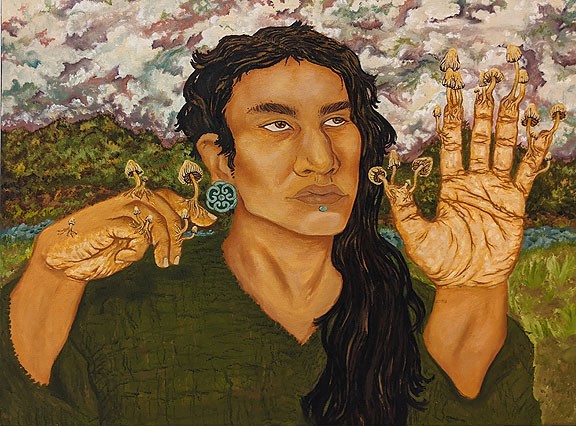
Untitled oil painting by Sage Alucero, 2020, as seen in San Diego.
One might join the mushroomers as an act of subversion, planning to help shift paradigms and consciousness through an embrace of all things mycological. In fact, while I was in San Diego in 2021, I stumbled on a community event at the Centro Cultural de la Raza at Balboa Park which featured dozens of small-scale artists and entrepreneurs selling all sorts of mushroom art, mushroom teas, spores, tinctures, etc. Many were focused on psychedelics but plenty took a broader approach. Bierend surprised me when in his penultimate chapter he ended visiting the same crowd in the San Diego area that I’d stumbled upon. Bierend’s book sealed the deal with his excellent political conclusions:
The scale and speed of the ecological and social degradation we collectively face simply will not be met by yet another innovation or technological patch, this time in an organismic shell, to be plucked from the store shelf or ordered from Amazon. That’s a tough reality to accept when the challenges are so dire and so pressing, and our habit of seeking a “fix” so deeply ingrained. Fungi themselves, though, are patient, adaptable, and abiding; they don’t repair, per se—there is no ‘original state’ of nature to which they or we can return—but rather facilitate and actualize. Perhaps what fungal fellowship teaches us is to question our unsustainable systems and change them, not to bury them under mushrooms and hope they’ll emerge fixed. It’s my opinion that what makes fungi so compelling is not the ways in which we can seize them to our benefit but the ways they can serve as partners and even teachers in the project of realizing more integrative, reciprocal ways of thinking and, therefore, being. (p. 277)
Jared Farmer’s newest book, Elderflora: A Modern History of Ancient Trees, matches the brilliance of his earlier Trees in Paradise. Elderflora offers a surprising overview of the history of tree-ring dating (dendochronology) and more recent attempts to build scientific knowledge by correlating carbon-dating with trees rings and other sources to pinpoint historic droughts, floods, etc. A telling bit of information for our hand-shaking era of anticipatory disaster is presented:
Between 699 and 823 CE, sequoias endured fourteen years of restricted growth. By contrast, the period from 1850 to 1950—California’s first century as a US state—exhibited the lowest frequency of drought for any hundred-year period in the last two millennia. In other words, Euro-American colonizers reaped the rewards of the dumbest luck… Seven megadroughts occurred between 860 and 1600 CE, including a thirty-year period leading up to 1300 CE, by which point Chaco Canyon’s social and ritual life had collapsed. (p. 210)
All this is to say that we are learning more all the time about all the life forms around us, even while we are ever more conscious that we are at the end of a uniquely wet and abundant period of time (roughly coequal with California as a state!). We are not only not alone, there are millions of species we haven’t even said hello to yet! The seafloor abounds with undiscovered life. The remaining rainforests, too. Countless initiatives percolate around the globe, trying to connect, or reconnect to the wider web of life. Breaking with the dominionist, Christian logic that proposes Earth as humanity’s to do with it as it pleases is well under way, though far from complete. The myriad citizen science initiatives, combined with the work of historians, sociologists, biologists, anthropologists, and many others, is shifting the foundations of common sense—but is it happening fast enough to facilitate a break with the dominating powers that insist on (literally) pouring gasoline on a burning planet, all for the sake of more power and money for them?
Annalee Newitz transcends the limits of our discussions of animal intelligence in her newest novel The Terraformers. In it she attributes full consciousness and personhood not only to all sorts of animals but also to countless artificial devices. In her futuristic novel set on a planet called Sasky tens of thousands of years from now, all life forms, including homo sapiens and drones and “boring machines” that traverse hot lava tunnels, are designed and decanted. Only those created by private companies to serve as “mounts” or to do drudge labor are deliberately modified into having less than fully human capabilities (though they all seem to be fully human inside and behind the constraints that are artificially imposed on them). Annalee manages to present a plausible world, still fraught with class conflict, but in which eons of bioengineering have shattered any boundaries of gender, bodies, species, or machines, all of which engage in complicated politics and romantic lives in her book. Getting out of our predicament seems to land us in a variety of familiar but different ones! Who’d a thunk it?
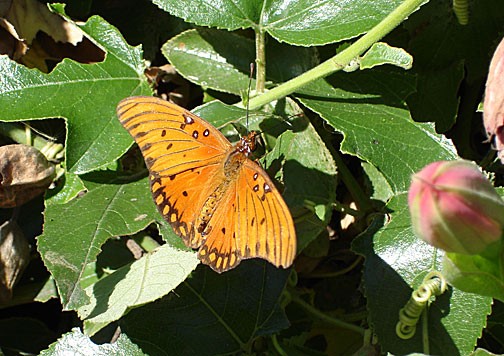
Butterfly thriving in Alemany Farm in 2005.
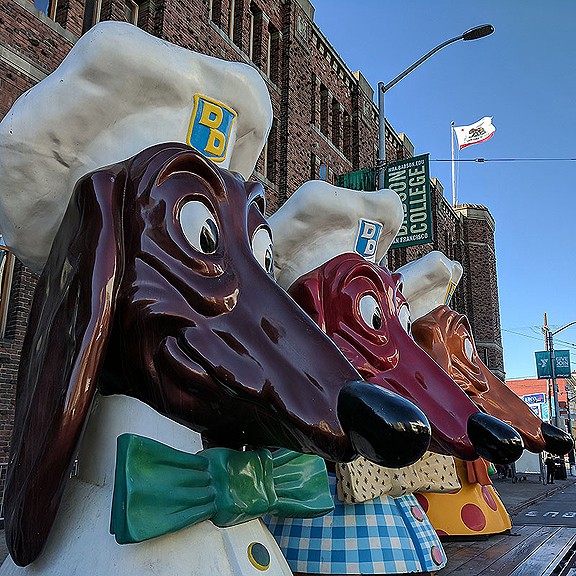
The Dogs!
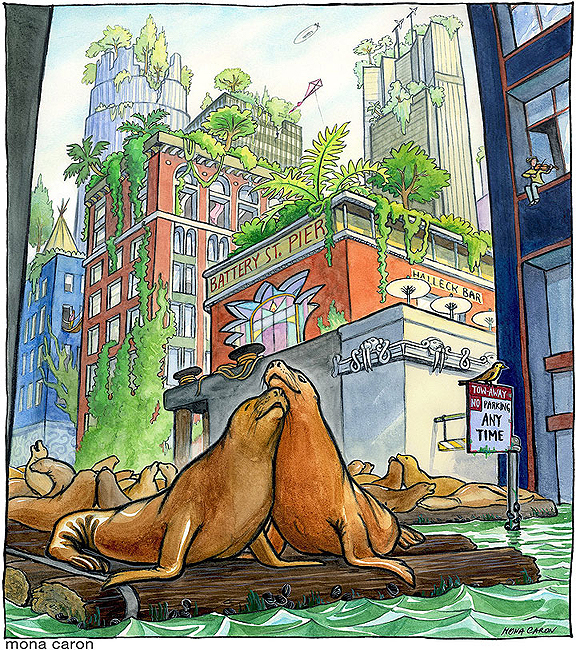
Sea lions floating in a flooded financial district as illustrated by Mona Caron.












Fine musings and readings. If you are interested in fungi and shrooms, which I am not because of a faulty preference for social science over biology, Nicholas P. Money us an amazing mycologist, who just also happens to write some profoundly collapse-aware analyses of the human predicament.
Who can blog or write with such incontestable evidence in every institutional domain of the global rule of psycopathic morons?
Shit’s been toast since the Nixon era, and American power always seems to recrudesce to that evil archetype. Silence is also resistance, especially when a first round of COVID hits with fatigue and sinus pressure. If you can keep rocking’ the mic, more credit to you, but for me it’s all rage, antipathy, and disgust, and there’s no upmarket for that.